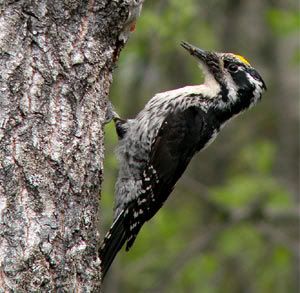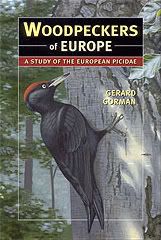 Measurements: Length 21- 22 cm. Wingspan 32-35 cm. The Three-toed is a small woodpecker, between the slightly larger (c.10%) Great Spotted Woodpecker and slightly smaller (c.10%) Middle Spotted in size. This species is unique amongst European woodpeckers (but not globally) in that it only has three toes on each foot whereas all its relatives have four, hence its scientific and vernacular names, but this rarely visible in the field. Though it is reduced in size in other woodpeckers, the first digit, which is the inner rear toe (the hallux) has been lost altogether by this species. The remaining rear toe (digit 4) always points backwards and is not rotated, as is often the case with “four-toed" woodpeckers. Three-toed appears compact, stocky, large headed, short-necked and blunt tailed. On perched view appears rather dark, blackish, mainly because of minimal white on wings (compare with Dendrocopos woodpeckers). Races differ slightly in plumage, nominate described here. Viewed from the rear, when clinging to tree trunk or at the nest-hole, shows a white Y-front formed by a white back panel being joined by white bars on the sides of head. A black stripe also runs down from the nape to the mantle. Throat and chest white, flanks and lower under-parts cream or dirty white rather than clean white and lightly marked with grey bars and/or streaks. Paler in flight when cream-buff under-parts become visible. Black face with white markings rather than the inverse as in Dendrocopos species. White supercilium broadens as it extends backward from the red eye. Merges with white post-auricular stripe and sweeps down to mantle. White sides to head crossed by a sweeping black band over the ear-coverts from lores to hind-neck. Also a thick black malar stripe which runs down from the bill base to the upper chest. Often white space between bill base and malar. Throat and upper breast white. Innermost scapulars, lower back and rump black, outer scapulars and upper-tail coverts brownish. Wings not as glossy black as black body. Wing-coverts occasionally finely dotted white, flight feathers with bolder white spots creating a barred effect. Mostly black tail with outer three rectrices dotted with white. Bill is relatively long and broad at the base. Grey with darker tip but paler base to lower mandible. Iris dark red. Legs grey. The photo above shows a classic adult male tridactylus race, in Finland (Harri Taavetti)
Measurements: Length 21- 22 cm. Wingspan 32-35 cm. The Three-toed is a small woodpecker, between the slightly larger (c.10%) Great Spotted Woodpecker and slightly smaller (c.10%) Middle Spotted in size. This species is unique amongst European woodpeckers (but not globally) in that it only has three toes on each foot whereas all its relatives have four, hence its scientific and vernacular names, but this rarely visible in the field. Though it is reduced in size in other woodpeckers, the first digit, which is the inner rear toe (the hallux) has been lost altogether by this species. The remaining rear toe (digit 4) always points backwards and is not rotated, as is often the case with “four-toed" woodpeckers. Three-toed appears compact, stocky, large headed, short-necked and blunt tailed. On perched view appears rather dark, blackish, mainly because of minimal white on wings (compare with Dendrocopos woodpeckers). Races differ slightly in plumage, nominate described here. Viewed from the rear, when clinging to tree trunk or at the nest-hole, shows a white Y-front formed by a white back panel being joined by white bars on the sides of head. A black stripe also runs down from the nape to the mantle. Throat and chest white, flanks and lower under-parts cream or dirty white rather than clean white and lightly marked with grey bars and/or streaks. Paler in flight when cream-buff under-parts become visible. Black face with white markings rather than the inverse as in Dendrocopos species. White supercilium broadens as it extends backward from the red eye. Merges with white post-auricular stripe and sweeps down to mantle. White sides to head crossed by a sweeping black band over the ear-coverts from lores to hind-neck. Also a thick black malar stripe which runs down from the bill base to the upper chest. Often white space between bill base and malar. Throat and upper breast white. Innermost scapulars, lower back and rump black, outer scapulars and upper-tail coverts brownish. Wings not as glossy black as black body. Wing-coverts occasionally finely dotted white, flight feathers with bolder white spots creating a barred effect. Mostly black tail with outer three rectrices dotted with white. Bill is relatively long and broad at the base. Grey with darker tip but paler base to lower mandible. Iris dark red. Legs grey. The photo above shows a classic adult male tridactylus race, in Finland (Harri Taavetti)
Monday, 10 September 2007
Three-toed Woodpecker: general ID
 Measurements: Length 21- 22 cm. Wingspan 32-35 cm. The Three-toed is a small woodpecker, between the slightly larger (c.10%) Great Spotted Woodpecker and slightly smaller (c.10%) Middle Spotted in size. This species is unique amongst European woodpeckers (but not globally) in that it only has three toes on each foot whereas all its relatives have four, hence its scientific and vernacular names, but this rarely visible in the field. Though it is reduced in size in other woodpeckers, the first digit, which is the inner rear toe (the hallux) has been lost altogether by this species. The remaining rear toe (digit 4) always points backwards and is not rotated, as is often the case with “four-toed" woodpeckers. Three-toed appears compact, stocky, large headed, short-necked and blunt tailed. On perched view appears rather dark, blackish, mainly because of minimal white on wings (compare with Dendrocopos woodpeckers). Races differ slightly in plumage, nominate described here. Viewed from the rear, when clinging to tree trunk or at the nest-hole, shows a white Y-front formed by a white back panel being joined by white bars on the sides of head. A black stripe also runs down from the nape to the mantle. Throat and chest white, flanks and lower under-parts cream or dirty white rather than clean white and lightly marked with grey bars and/or streaks. Paler in flight when cream-buff under-parts become visible. Black face with white markings rather than the inverse as in Dendrocopos species. White supercilium broadens as it extends backward from the red eye. Merges with white post-auricular stripe and sweeps down to mantle. White sides to head crossed by a sweeping black band over the ear-coverts from lores to hind-neck. Also a thick black malar stripe which runs down from the bill base to the upper chest. Often white space between bill base and malar. Throat and upper breast white. Innermost scapulars, lower back and rump black, outer scapulars and upper-tail coverts brownish. Wings not as glossy black as black body. Wing-coverts occasionally finely dotted white, flight feathers with bolder white spots creating a barred effect. Mostly black tail with outer three rectrices dotted with white. Bill is relatively long and broad at the base. Grey with darker tip but paler base to lower mandible. Iris dark red. Legs grey. The photo above shows a classic adult male tridactylus race, in Finland (Harri Taavetti)
Measurements: Length 21- 22 cm. Wingspan 32-35 cm. The Three-toed is a small woodpecker, between the slightly larger (c.10%) Great Spotted Woodpecker and slightly smaller (c.10%) Middle Spotted in size. This species is unique amongst European woodpeckers (but not globally) in that it only has three toes on each foot whereas all its relatives have four, hence its scientific and vernacular names, but this rarely visible in the field. Though it is reduced in size in other woodpeckers, the first digit, which is the inner rear toe (the hallux) has been lost altogether by this species. The remaining rear toe (digit 4) always points backwards and is not rotated, as is often the case with “four-toed" woodpeckers. Three-toed appears compact, stocky, large headed, short-necked and blunt tailed. On perched view appears rather dark, blackish, mainly because of minimal white on wings (compare with Dendrocopos woodpeckers). Races differ slightly in plumage, nominate described here. Viewed from the rear, when clinging to tree trunk or at the nest-hole, shows a white Y-front formed by a white back panel being joined by white bars on the sides of head. A black stripe also runs down from the nape to the mantle. Throat and chest white, flanks and lower under-parts cream or dirty white rather than clean white and lightly marked with grey bars and/or streaks. Paler in flight when cream-buff under-parts become visible. Black face with white markings rather than the inverse as in Dendrocopos species. White supercilium broadens as it extends backward from the red eye. Merges with white post-auricular stripe and sweeps down to mantle. White sides to head crossed by a sweeping black band over the ear-coverts from lores to hind-neck. Also a thick black malar stripe which runs down from the bill base to the upper chest. Often white space between bill base and malar. Throat and upper breast white. Innermost scapulars, lower back and rump black, outer scapulars and upper-tail coverts brownish. Wings not as glossy black as black body. Wing-coverts occasionally finely dotted white, flight feathers with bolder white spots creating a barred effect. Mostly black tail with outer three rectrices dotted with white. Bill is relatively long and broad at the base. Grey with darker tip but paler base to lower mandible. Iris dark red. Legs grey. The photo above shows a classic adult male tridactylus race, in Finland (Harri Taavetti)
Subscribe to:
Post Comments (Atom)





No comments:
Post a Comment